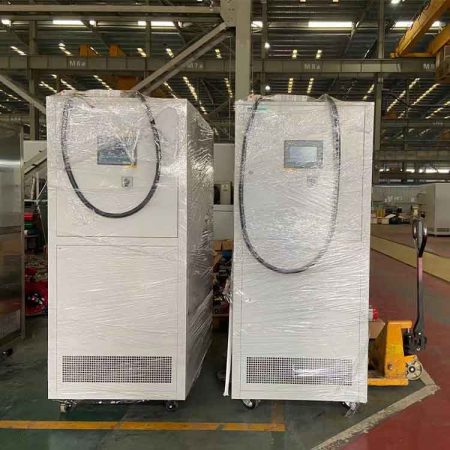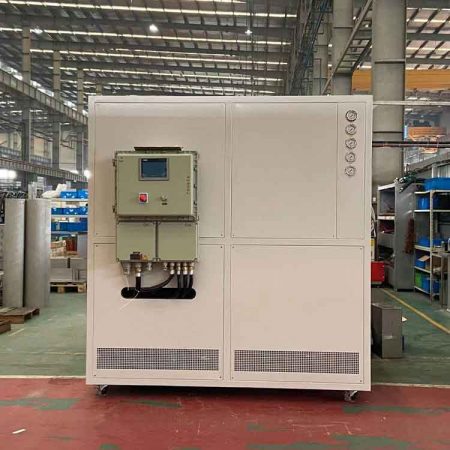Chiller Cooler System
Chiller cooler systems are required in commercial buildings as a means of producing a cooling effect. The purpose is to remove the building heat gained through the many internal and external loads. Some of the loads of these external influences include sunlight, wind, and outdoor temperature heat. Indoor factors include moisture from people, lighting, and electrical or mechanical equipment.
Chiller cooler systems move heat away from spaces that require climate control, just like traditional split systems or packaged units, but they use water (or aqueous solutions) instead of air to do so. There are two types of chillers: water-cooled and air-cooled. They work similarly for most of the process before the refrigerant reaches the condenser.

Two types of chiller cooler systems
Cooling systems are installed in commercial buildings to achieve proper temperature control. There are two types: water-cooled chillers and air-cooled chillers. Both are refrigeration systems used to cool fluids or dehumidify air in commercial and industrial facilities.
The components that make up water-cooled chillers and air-cooled chillers are very similar. Each product contains an evaporator, condenser, compressor and an expansion valve. The main difference is whether air or water is used to provide condenser cooling.
1. Air-cooled chiller cooler system
Typically, air-cooled chillers are installed in smaller buildings because these systems require more ductwork than water-cooled chillers. These units also contain all components packaged in a single cabinet and are called packaged cooling units. Connect ductwork throughout the building from individual HVAC units to each zone. Air-cooled chillers tend to be less energy efficient, especially when the points between base and service areas are far apart. Efficiency is also reduced if a single device serves multiple areas.
2. Water-cooled chiller cooler system
Larger commercial buildings and various construction campuses will use chillers to provide cooling. In these systems, chilled water is generated and piped to other air handling units throughout the building to serve individual tenant spaces, single floors, or several floors. Individual ductwork then runs from each air handler to the zone. Chilled water-based systems result in much less internal piping than all-air systems, as chilled water piping is used to transport thermal energy from the point of generation to the exact point of use. Additionally, chiller-based systems are more efficient in terms of space utilization within a building because components can be located elsewhere.

Advantages of chiller cooler system
Simply put, a chiller is a collection of individual components chosen to work together as a system. Although more expensive to install and more complex to operate, chillers offer advantages over packaged cooling units. These advantages include greater energy efficiency, better controllability and longer life. Additionally, chiller-based systems are more efficient in terms of space utilization within a building because components can be located elsewhere.
Large commercial buildings often locate their industrial chillers in mechanical equipment rooms close to the cooling process. Some industrial chillers may be located directly next to the process, depending on the size of the chiller and compressor. Architects and engineers can design systems to place equipment outdoors.
Correo electrónico: info@lneya.com WeChat ID: +8615251628237 WhatsApp: +86 17851209193

Enfriadoras de recirculación / Criotermostatos
El enfriador puede utilizarse ampliamente en diversas industrias y laboratorios, y admite diseños personalizados.
| Temperatura | Serie -25°C ~ +30°C | Serie -45°C ~ +30°C | Serie -60°C ~ -20°C | Serie -80°C ~ -20°C | Serie -120°C ~ -70°C | ||||
| Capacidad de refrigeración | 0,8 ~ 30 kW | 0,75 ~ 12 kW | 0,4 ~ 6kW | 0,2 ~ 6kW | 0,3 ~ 5kW | ||||
| Nota: Se puede personalizar cualquier rango de temperatura de -150℃ ~ +350℃ y cualquier capacidad de refrigeración. | |||||||||
 Enfriadoras de agua / Enfriadoras pequeñas
Enfriadoras de agua / Enfriadoras pequeñas
El enfriador puede utilizarse ampliamente en diversas industrias y laboratorios, y admite diseños personalizados.
| Temperatura | -18°C ~ +30°C | Serie +5°C ~ +35°C | |||||||
| Capacidad de refrigeración | 0,35 ~ 0,9 kW | 1,8 ~ 50 kW | |||||||
| Nota: Se puede personalizar cualquier rango de temperatura de -150℃ ~ +350℃ y cualquier capacidad de refrigeración. | |||||||||

Refrigeradores de baja temperatura
Estamos especializados en la producción de refrigeradores de baja temperatura con un rango de control de temperatura de hasta -150°C, que pueden satisfacer las necesidades de refrigeración de diferentes industrias.
| Temperatura | Serie -25°C ~ -5°C | Serie -45°C ~ -10°C | Serie -60°C ~ -10°C | Serie -80°C ~ -30°C | Serie -110°C ~ -50°C | Serie -150°C ~ -110°C | |||
| Capacidad de refrigeración | 12 ~ 360 kW | 6 ~ 180 kW | 6 ~ 180 kW | 4 ~ 180kW | 2 ~ 120kW | 2,5 ~ 11 kW | |||
| Nota: Se puede personalizar cualquier rango de temperatura de -150℃ ~ +350℃ y cualquier capacidad de refrigeración. | |||||||||

Enfriadoras y calefactoras
Rango de control de temperatura: -120°C a +350°C
Application: Various Reactors (Microchannels, Glass, Jacketed Reactors, etc.), Distillation or Extraction System, Laboratory, University, Research Institute, Aerospace, Automotive Industry, Semiconductor and Electrical Test, Chemical, Pharmaceutical, Petrochemical, Biochemical, Medical, Hospital, R&D Workshop, Aerospace, Biological and Other Industries.
| Temperatura | Serie -10 ~ +150°C | Serie -25 ~ +200°C | Serie -25 ~ +300°C | Serie -45 ~ +250°C | Serie -45 ~ +300°C | Serie -60 ~ +250°C | Serie -60 ~ +300°C | Serie -70 ~ +250°C | Serie -80 ~ +250°C | Serie -90 ~ +250°C | Serie -100 ~ +100°C | ||
| Capacidad de refrigeración | 1,5 ~ 15 kW | 1 ~ 200 kW | 1 ~ 200 kW | 0,45 ~ 200 kW | 0,9 ~ 25 kW | 0,25 ~ 60 kW | 0,75 ~ 25 kW | 0,4 ~ 15 kW | 0,3 ~ 80 kW | 0,2 ~ 80 kW | 0,45 ~ 80 kW | ||
| Nota: Se puede personalizar cualquier rango de temperatura de -150℃ ~ +350℃ y cualquier capacidad de refrigeración. | |||||||||||||

Enfriadoras de recirculación
Rango de control de temperatura: -45°C a +250°C
Application: Various Reactors (Microchannels, Glass, Jacketed Reactors, etc.), Distillation or Extraction System, Laboratory, University, Research Institute, Aerospace, Chemical, Pharmaceutical, Petrochemical, Biochemical, Medical, Hospital, R&D Workshop, Aerospace, Biological and Other Industries.
| Temperatura | Serie -25°C ~ +200°C | Serie -45°C ~ +250°C | |||||||
| Capacidad de refrigeración | 1 ~ 15 kW | 0,25 ~ 15 kW | |||||||
| Nota: Se puede personalizar cualquier rango de temperatura de -150℃ ~ +350℃ y cualquier capacidad de refrigeración. | |||||||||
 LNEYA
LNEYA
 简体中文
简体中文


















































































